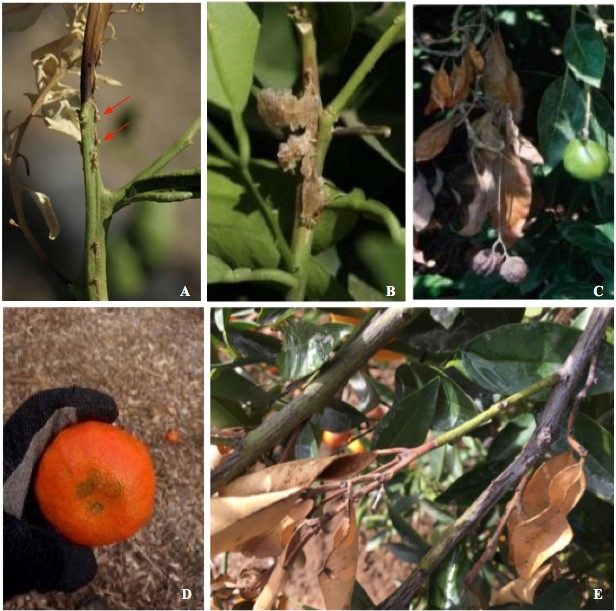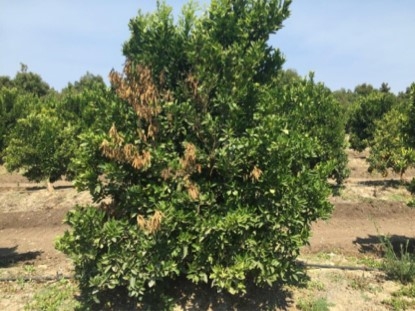Botryosphaeria Gummosis and Dieback
of Citrus
DeAnna Vega, M.S. Candidate, CSU-Pomona
Botryosphaeria dieback or Botryosphaeria gummosis (formerly known as Dothiorella gummosis on citrus), is found worldwide on many horticultural and agricultural crops. Multiple species of the fungus can often be found on a tree at any given time. Bot canker has a latent stage where it can exist within a tree for years without showing any symptoms. Most species are opportunistic, relying on plants to become stressed before it can infect the tree. The fungus can infect the scion, rootstock, and surface roots of a tree. Disease symptoms include; necrosis of the blossoms, shoots, and fruit. Botryosphaeria can lead to wilt, leaf lesions/spots, and fruit rot. Cankers along the stem, twigs, and branches are sunken necrotic (dead) areas with gum exuding from the bark. Transverse section (cross section) exposes wedged or irregular stained sections of infection ranging in color from gray to brown. Infected cambial wood can appear brown to yellowish in color. Extensive dieback, even mortality in extreme cases particularly with younger trees, can occur. Some unique characteristics of Botryosphaeria are black pustules (pycnidia – a type of fungal fruiting body) grouped together on the surfaces of or heavily infested bark.
Figure 1. Gummosis on blighted twig – red arrows pointing to gummosis exudates (A).
Canker with older exude (B). Blighted foliage and fruit (C). Botryosphaeria
sp. on fruit (D). Blighted twig (E). Photos courtesy of Ben Faber.
The pathogen favors warm weather from 20°C - 30°C (68°F - 86°F) and rainfall. When, temperatures rise above 10°C (50°F), spores are released to spread the disease in spring. In California, new year's infection typically starts in early April and the middle of spring (late May through June) from previously infected buds, where the disease had not fully developed. Infected buds produce shoots that are infected with the disease. The infected areas can become blighted within three to five days. Symptomatic leaves turn chlorotic (taking on a yellowish and sometimes mottled appearance), wilt, and becomes blighted along with the twig. Flagging (blighted and dead branches) occurs throughout the canopy where the disease has infected.
Figure 2. Flagging in canopy from multiple blighted twigs. Photo courtesy of Ben Faber.
Control and management of the disease depends on cultural practices, chemical control, and integrated disease control management (Michailides & Morgan, 2004). Cultural disease control practices include; pruning, and timing of pruning, avoid pruning or mechanical damage during the rainy season. Prune cankered limbs two to five inches below diseased wood. Remove pruned away dead wood from the field prior to rainy/moist periods. Disinfect pruning tools with quarter strength household bleach – can be corrosive, 100% Lysol, or surface sterilize by flame. Use drip irrigation when possible and avoid wetting the trunk and canopy of trees. When necessary, irrigate with lower pressure to avoid misting and fogging that adds to humidity. Remove weeds to reduce the humidity and habitats for other insect pests. Insects, birds, and irrigation water can aid in disseminating the disease.
Be vigilant in scouting and remove the first sources of inoculation in summertime and repeat until disease is difficult to find. Remove and burn brush from the orchard as the disease can remain viable for as long as three to six years (Michailides & Teviotdale, 2014; Michailides & Morgan, 2004) in woody debris. When possible, protect tress from stressors (water, heat, mechanical injury, salinity, frost, nutrition deficiencies, or sunburn). Soil borne pathogens can predispose plants to Botryosphaeria gummosis by disrupting water and nutrient flow. Insect pests (such as scale) can also increase disease incidents as much as 50% or higher.
Integrated pest management is crucial to mitigating this disease. Buy clean nursery stock. Keep active monitoring regimes. Surface disinfect tools and equipment between cuts. Control other diseases (such as soilborn pathogens) and insect pests. Whitewash when necessary. Most importantly, follow proper irrigation and fertilizer regimens to ensure plant health.
and there's more:
http://ceventura.ucanr.edu/newsletters/Topics_in_Subtropics80946.pdf
References
Adesemoye, A. O., Eskalen, A., Faber, B., & O'Connell, N. (2011). Multiple Botryosphaeria species causing “Dothiorella” gummosis in citrus. Citrograph, 2(2), 32-34.
Faber, B. Citrus ID and Control. University of California Agriculture and Natural Resources Statewide Integrated Pest Management Program.
Michailides, T.J., Morgan, D. P., (2004). Panicle and Shoot Blight of Pistachio: A Major Threat to the California Pistachio Industry. American Phytopathological Society. http://www.apsnet.org/publications/apsnetfeatures/Pages/Pistachio.aspx
Michailides, T.J., Teviotdale, B.L., (2014). Pistachio: Botryosphaeria Panicle and Shoot Blight. University of California Agriculture and Natural Resources Statewide Integrated Pest Management Program. http://ipm.ucanr.edu/PMG/r605100311.html

